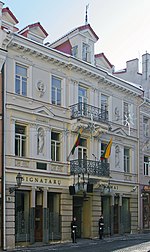Lithuanian National Museum
Lietuvos nacionalinis muziejus , the Lithuanian National Museum , is a state-funded historical museum in Vilnius , Lithuania , founded in 1855 , which comprises several significant buildings and whose holdings include numerous objects and written documents. The museum organizes and coordinates archaeological excavations in Lithuania.
history
The Museum of Antiques in Vilnius ( Polish: Muzeum Starożytności w Wilnie ) was founded in 1855 by Eustachy Tyszkiewicz and was a forerunner of today's museum. At the beginning, the museum focused its collection on the culture and history of the Grand Duchy of Lithuania . It was well known and attracted large numbers of visitors. After the January uprising of 1863 , the authorities of the Russian Empire moved a large part of the collection to Moscow , the remainder was rearranged and incorporated into the Vilnius Public Library. The museum and library worked together from 1866 to 1914. As the Eastern Front of World War I approached Vilnius in 1915, more parts of the exhibition were brought to Russia .
After the independence of Lithuania in 1918, the Museum of History and Folklore was established, which was put together from the remaining holdings of the Museum of Antiquities and those of the Lithuanian Scientific Society. Its director was Jonas Basanavičius , one of the signatories of the Lithuanian Declaration of Independence . After 1919 Vilnius became part of the Second Polish Republic and the museum was attached to Vilnius University .
In 1941 the Academy of Sciences took over the collections of all the city's museums. In 1952, the museum regained its independence under the direction of the historian Vincas Žilėnas . In 1967 it moved to new premises in the New Arsenal of the Vilnius Castle Complex . In the two decades that followed, the museum acquired historical materials from around the country. It was given its current name in 1992 and is now subordinate to the Ministry of Culture.

organization
The museum consists of five main departments (history and contemporary history, archeology, folklore, numismatics and iconography) and has around 800,000 individual items.
The collection includes:
- The old arsenal of the castle complex
- The new arsenal of the castle complex
- The Gediminas Tower on Castle Hill
- Kazys Varnelis House and Museum
- The House of the Signatories
- The bastion of the defensive wall
- (all in Vilnius)
- The estate of Dr. Jonas Šliūpas in Palanga
- The Museum of Dr. Vincas Kudirka in the Šakiai district
There is also a department for information and training, a department for the listing and preservation of exhibits, a department for restoration and a department for publications.
swell
- Museum official website (lit.)
- Museums of Lithuania (Engl.)
Coordinates: 54 ° 41 ′ 14 ″ N , 25 ° 17 ′ 21 ″ E
